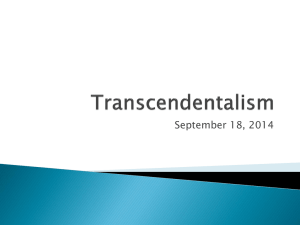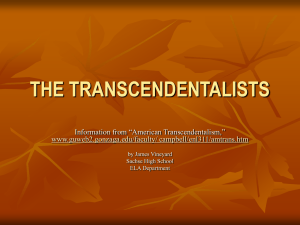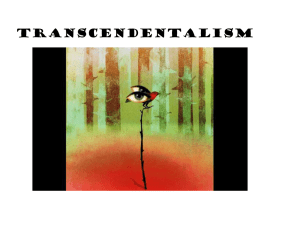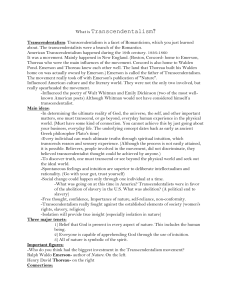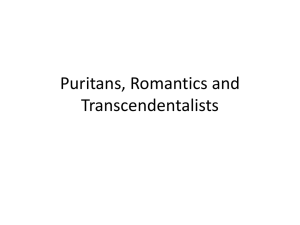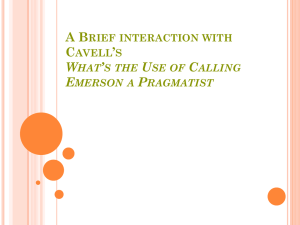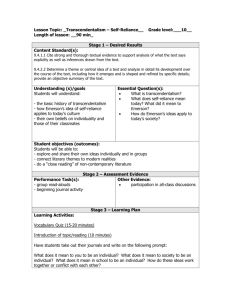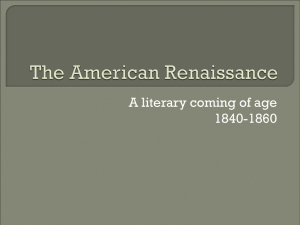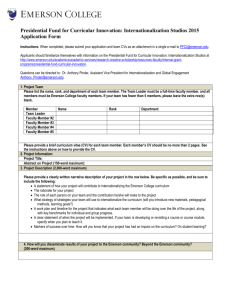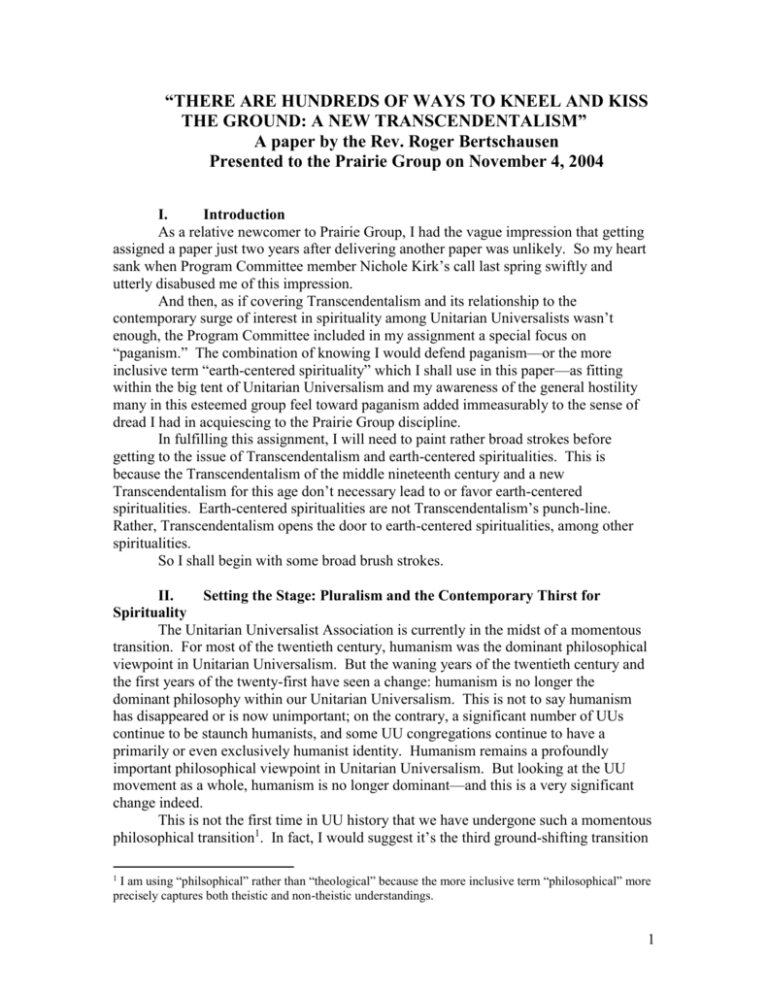
“THERE ARE HUNDREDS OF WAYS TO KNEEL AND KISS
THE GROUND: A NEW TRANSCENDENTALISM”
A paper by the Rev. Roger Bertschausen
Presented to the Prairie Group on November 4, 2004
I.
Introduction
As a relative newcomer to Prairie Group, I had the vague impression that getting
assigned a paper just two years after delivering another paper was unlikely. So my heart
sank when Program Committee member Nichole Kirk’s call last spring swiftly and
utterly disabused me of this impression.
And then, as if covering Transcendentalism and its relationship to the
contemporary surge of interest in spirituality among Unitarian Universalists wasn’t
enough, the Program Committee included in my assignment a special focus on
“paganism.” The combination of knowing I would defend paganism—or the more
inclusive term “earth-centered spirituality” which I shall use in this paper—as fitting
within the big tent of Unitarian Universalism and my awareness of the general hostility
many in this esteemed group feel toward paganism added immeasurably to the sense of
dread I had in acquiescing to the Prairie Group discipline.
In fulfilling this assignment, I will need to paint rather broad strokes before
getting to the issue of Transcendentalism and earth-centered spiritualities. This is
because the Transcendentalism of the middle nineteenth century and a new
Transcendentalism for this age don’t necessary lead to or favor earth-centered
spiritualities. Earth-centered spiritualities are not Transcendentalism’s punch-line.
Rather, Transcendentalism opens the door to earth-centered spiritualities, among other
spiritualities.
So I shall begin with some broad brush strokes.
II.
Setting the Stage: Pluralism and the Contemporary Thirst for
Spirituality
The Unitarian Universalist Association is currently in the midst of a momentous
transition. For most of the twentieth century, humanism was the dominant philosophical
viewpoint in Unitarian Universalism. But the waning years of the twentieth century and
the first years of the twenty-first have seen a change: humanism is no longer the
dominant philosophy within our Unitarian Universalism. This is not to say humanism
has disappeared or is now unimportant; on the contrary, a significant number of UUs
continue to be staunch humanists, and some UU congregations continue to have a
primarily or even exclusively humanist identity. Humanism remains a profoundly
important philosophical viewpoint in Unitarian Universalism. But looking at the UU
movement as a whole, humanism is no longer dominant—and this is a very significant
change indeed.
This is not the first time in UU history that we have undergone such a momentous
philosophical transition1. In fact, I would suggest it’s the third ground-shifting transition
I am using “philsophical” rather than “theological” because the more inclusive term “philosophical” more
precisely captures both theistic and non-theistic understandings.
1
1
in American UU history. The first happened in the 1830s and 40s, when Unitarian
Transcendentalists rejected the Christian domination of their faith in favor of a more
eclectic approach. Central to this rejection was the Transcendentalist challenge of the
Bible as the only or even the principal source of divine revelation. Transcendentalist
Unitarians declared that there are equally insightful truths to be discovered in the sacred
texts of other world religions—and in nature and even in our own souls. The upshot of
the Transcendentalist revolution, worked out over many decades, was this: Christianity
was no longer the dominant philosophical viewpoint in Unitarianism. Instead, a more
general theism became the dominant philosophy. Although Christianity was no longer
the dominant viewpoint, a significant number of Unitarians continued to identify
themselves as Christian.
The second momentous philosophical transition occurred in the early part of the
twentieth century: humanism replaced theism as the dominant philosophical viewpoint in
Unitarianism. Once again, the viewpoint that lost dominance did not become extinct in
Unitarian circles. Theism simply was no longer dominant. And now we are in the third
enormous transition in American Unitarian Universalism: the end of humanism as our
dominant philosophy.
Why is this transition happening now? Primarily it is a reflection of a wider trend
in our American culture: a resurgence of interest in spirituality that dates back to the
1960s. For these past thirty or forty years, Americans in vast numbers have turned to
spirituality, chiefly I believe in an effort to discover ways to cope with and understand all
of the challenges of our age. This trend shows no sign of abating.
One principal place Americans are looking for spirituality is in evangelical
Christian churches, which are in the midst of an explosion in growth and vitality. This is
certainly evident in my hometown of Appleton, Wisconsin, where four evangelical
Christian churches now each have several thousands of members, while Catholic,
Lutheran and other main line congregations are mostly mired in a decades-long decline.
Just in the past couple years, two of these huge evangelical churches have built new
facilities to the tune of nine million dollars each—and that represents only the first phase
of their long-term construction plans. The only mainline church to approach this kind of
explosive growth in the Appleton area is a Lutheran church which is attempting to mimic
the style and fervor of these four evangelical congregations.
Eugene Taylor highlights the significance of this contemporary spiritual
resurgence when he compares it to the First Great Awakening that took place in the years
before the Revolutionary War, and to the Second Great Awakening that took place in the
middle years of the nineteenth century.2 Though many people tend to associate the
earlier awakenings with more conservative religious expressions, Taylor asserts that the
first two Awakenings historically were expressed in liberal as well as conservative
congregations. He persuasively makes the case, for example, that Transcendentalism can
be understood in part as an expression of a resurgence of interest in spirituality in liberal
(mostly Unitarian) congregations. He argues that the contemporary spiritual awakening
also finds expression in both liberal and conservative congregations.3
2
Eugene Taylor, Shadow Culture: Psychology and Spirituality in America (Washington, D.C.:
Counterpoint, 1999), p. 19.
3
Ibid., pp. 18-21.
2
As was the case in liberal as well as conservative congregations in the previous
Awakenings, an important aspect of this contemporary Awakening is a desire for more
emotional expression in spirituality—a desire to make sure the heart as well as the head
are addressed in ones spiritual life. Though certainly it is manifested in ways quite
different from evangelical Christian churches, we can see in recent years this resurgence
of interest in a more emotional spirituality in many—probably most—UU congregations
as well. The upsurge in a more emotional spirituality has been widely noted and
discussed in UU circles for more than a decade now. For many UUs, the once dominant
humanist philosophical orientation has not felt conducive to spirituality and a higher
emotional content. There is therefore a correlation between the rise in interest in a more
emotional spirituality and the loss of humanism’s dominance.
Rather than leading to a particular spiritual expression, the search for more
spirituality has led UUs to an increasingly wide array of spiritualities and religious
traditions. This is certainly evident in the adult programming in my congregation, which
includes Native American talking circles, Zen Buddhist and Tibetan Buddhist meditation
groups, earth-centered drumming circles, a goddess group, a primarily Christian prayer
group as well as humanist groups.4 This pluralism of spiritualities reflects the eclecticism
that Taylor observes in contemporary American culture.
As discussed above, in looking at the history of dominant philosophical
orientations within Unitarian Universalism, an important point is that this is not the first
time in our history that a dominant philosophy has lost its pre-eminence. But I hope it
will be the last. I say this because I believe a genuine pluralism within Unitarian
Universalism is poised to take the place of any particular dominant philosophy. Instead
of some new philosophy marching in to take the place of humanism—which took the
place of theism, which took the place of Christianity—I am hoping that we will no longer
have a dominant philosophical viewpoint: not Christianity, not theism, not humanism, not
any particular philosophy or theology.
This is exactly what is happening in my congregation. Once dominated by
humanists, my congregation no longer has a dominant philosophical viewpoint. We have
humanists, and Christians, and theists, and pagans, and Buddhists, and Native Americans,
and Hindu and Muslim members, among others. What’s more, we are pretty evenly
spread along the philosophical spectrum. All of these spiritual paths and more are
welcome in our big tent which is the Fox Valley Unitarian Universalist Fellowship. Our
rapid growth has been fueled more than anything else by this noteworthy but not always
easy transition to a pluralism of philosophical and spiritual orientations.
Of course some might argue that pluralism is itself a philosophical orientation or
ideology, little different from Christianity, theism or humanism. I reject this argument: I
think that because of its expansiveness, pluralism is qualitatively different from a
particular philosophical viewpoint. Pluralism lacks the more restrictive boundaries of a
particular philosophy or theology. Take Christianity, for example. While there are
countless variations of Christianity, they all are bounded by certain notions: the centrality
of Jesus’ message to one’s spirituality, for example. This type of boundary is not present
in pluralism.
Perhaps a definition of “pluralism” will help. I like Diana Eck’s definition:
4
I should add that these groups are led by UUs who are not merely wannabes: Native American talking
circles are led by Native Americans, the Zen Buddhist group is led by Zen Buddhists, etc.
3
Pluralism is not an ideology, not a leftist scheme, and not a free-form
relativism. Rather, pluralism is the dynamic process through which we
engage with one another in and through our very deepest differences.5
Pluralism, she also writes, is not just about the differences between people, but
also about “engagement, involvement, and participation” between diverse people.
Pluralism “requires participation, and attunement to the life and energies of one another.”
Essential to true, thriving pluralism is a sense of respect, mutuality and reciprocity as
people with different beliefs and understandings deeply engage with one another. And
Eck asserts that pluralism isn’t about “finding a common faith that is acceptable to all,
watering down one’s own faith so it will be palatable to someone of another faith.”6
My central goal at the Fox Valley UU Fellowship is to embody Eck’s vision of
pluralism. People with different philosophies, theologies or spiritualities must not just
hang out among those of similar orientation, but must also engage with those in the
congregation who have different orientations. When this happens, then my Fellowship
will be truly pluralistic. It’s not enough for members of the Zen Buddhist meditation
group and the Native American talking circle and the Christian prayer group to interact
only within their groups; they must also engage with one another across the religious
divides that separate them, sharing with one another the differences and the
commonalities of their particular philosophical orientations. The point is not for all of
these folks to arrive at a common (melting pot) spiritual viewpoint, but rather for each
person to go deeply into his or her viewpoint and to share its depth with others who don’t
hold that viewpoint. In doing so, the individual spiritual journeys of those on both ends
of the dialogue will deepen. And members will experience first-hand something the
world desperately needs: the opportunity to talk with rather than oppress or kill people
who hold different religious viewpoints.
III.
The Seeds of Contemporary UU Pluralism
I believe that the seeds of this contemporary pluralism in Unitarian Universalism
can be found in our own UU religious tradition—and particularly in Transcendentalism.
I should take a moment to make explicit the claim that Transcendentalism is a part of our
UU heritage. Although Transcendentalism labels a movement that encompassed more
than our faith, we can certainly consider Transcendentalism to be part of our UU heritage.
As Capper and Wright note, with few exceptions Transcendentalism “grew in the
spiritual soil of American Unitarianism.”7 Transcendentalism was us—and is, as I shall
argue, us.
The seeds of the pluralism so central to contemporary Unitarian Universalism are
manifest in Transcendentalism in three different ways. First and foremost, the
Transcendentalists put individual freedom at the heart of the liberal religious journey.
5
Diana Eck, A New Religious America (San Francisco: HarperSanFrancisco, 2001), p. 70.
Ibid., pp. 69-70, 370.
7
Charles Capper and Conrad Wright, eds., The Transient and the Permanent: The Transcendentalist
Movement and Its Context, (Boston: Massachusetts Historical Society, 1999), p. X. David Robinson in “A
Religious Demonstration: The Theological Emergence of New England Transcendentalism” in Capper and
Wright, pp. 51, 58 and Lawrence Buell, Emerson (Cambridge, MA: Belknap Press, 2003), p. 33 also make
this link.
6
4
Transcendentalism’s pivotal shift of the locus of authority from a sacred book, leader or
tradition to the intuition of the individual paved the way for the centrality of individual
freedom. As Lawrence Buell notes, Emerson’s central project was “the unchaining of
human minds”8—unchaining human minds from creeds and dogmas and conventions.
Emerson’s resignation from Boston’s Second Unitarian Church illustrates the
primacy he put on the freedom of the individual. He resigned because he refused to
administer the communion ritual. Given the centrality of communion in the Christian
church, this was, of course, no minor issue. Staking out a stark position on
communion—“I won’t do it”—certainly got people’s attention and crystallized the full
implication of the shift in the locus of authority. In a sermon outlining his position, he
articulated a strong claim for individual freedom—including the freedom to abandon
communion for no other reason than that he no longer found it suitable:
To pass by other objections, I come to this, (that) this mode of
commemorating Christ is not suitable to me. That is reason enough why I
should abandon it. If I believed that it was enjoined by Jesus on his
disciples, and that he even contemplated to make permanent this mode of
commemoration…and yet on trial it was disagreeable to my own feelings,
I should not adopt it…I am not engaged to Christianity by decent forms; it
is not saving ordinances, it is not usage, it is not what I do not understand
that engages me to it—let these be the sandy foundation of falsehoods.
What I revere and obey is its deep interior life…Freedom is the essence of
Christianity…Its institutions should be as flexible as the wants of men.
That form out of which the life and suitableness have departed should be
as worthless in its eyes as the dead leaves that are falling around us.9
As Buell notes about this statement: “Here for the first time in public Emerson
becomes Emerson, the Emerson of the later essays who affirms the divinity of the self,
the cornerstone of Transcendentalism.”10 Emerson makes this even more explicit several
years later in the Divinity School Address when he asserts that what was most significant
about Jesus was that he “saw with open eye the mystery of the soul:” namely, that “God
incarnates himself in man.” According to Emerson, Jesus said in this “jubilee of sublime
emotion,” “‘I am divine. Through me, God acts; through me, speaks. Would you see
God, see me; or see thee, when thou also thinkest as I now think.’”11 The divinity of the
self becomes the central truth of Christianity, and the central truth of Emerson’s
increasingly universalistic faith. And with this truth comes a corresponding truth for
Emerson: “Freedom is the essence of Christianity,” as well as the essence of Emerson’s
increasingly post-Christian faith.
Along with shifting the locus of authority from scripture or dogma to the
individual self, affirming the divinity of the self necessarily opens the door to a broader
8
Buell, p. 9. Robert Richardson, Jr., Emerson: The Mind on Fire (Berkeley: University of California Press,
1995), p. 185, makes a similar point when he asserts that the central theme of Emerson after mid-1830s was
the autonomy and sufficiency of the individual consciousness.
9
Emerson quoted in Buell, p. 16.
10
Ibid., p. 16.
11
Ralph Waldo Emerson in The Portable Emerson, Carl Bode, ed. (New York: Viking Penguin, 1981), pp.
77-78.
5
range of spiritual understandings: the limitation of scripture or dogma now departed,
individuals contemplating their own souls will come to different and distinct conclusions.
A plurality of spiritual understandings will be the inevitable result. And this was exactly
what happened among Transcendentalists.
One conclusion to which many Transcendentalists came—including Emerson,
Henry David Thoreau and Margaret Fuller—was that Christianity has no special or
unique spiritual claim or authority.12 What Buell calls Transcendentalism’s
“dethronement”13 of Christianity from its paramount position is the second root of
contemporary UU pluralism to be found in the soil of Transcendentalism. While some
Transcendentalists like Theodore Parker continued to identify themselves as Christian
even as they rejected the notion that only Christianity contains truth,14 others like
Thoreau more explicitly departed from Christianity. 15
The loss of Christianity’s paramount place can be seen in proposed or actual
Transcendentalists’ changes to the liturgy—for example, Emerson’s attempt to dispense
with communion, or Parker’s addition of a non-biblical reading to the liturgy.16 Echoes
of these Transcendentalist changes in the liturgy can be heard in today’s UU worship.
Significantly, though, no Transcendentalist suggested that another particular
tradition should take the place of Christianity in the center of Unitarian faith. This, too,
opened the door to tremendous plurality of spiritual understandings that characterizes
mid-nineteenth century Transcendentalism as well as Unitarian Universalism today.
Emerson concludes that Jewish and Christian scriptures contain only fragmentary
glimpses of truth. Look for other teachers to augment the fragmentary truths of these
scriptures, he recommends in the Divinity School Address.17 And in his journal, he
writes: “Make your own Bible (from) all those words & sentences that in all your reading
have been to you like the blast of trumpet.”18
And this is precisely what the Transcendentalists did. In fact, this charge to
“make your own Bible” led to the publication of the “Ethnical Scriptures” in the Dial—a
collection of sacred scriptures from around the world. As Eck notes, with this publication
“scripture” became “scriptures.”19 The source of scriptural truth became plural. This is
the third way in which contemporary UU pluralism is rooted in Transcendentalism.
Encouraging individuals to draw sustenance from an expansive definition of scripture is
an important principle in both Transcendentalism and contemporary UU spirituality.
Many Transcendentalists, including Emerson and Thoreau, looked in particular to
the scriptures of the East for a new teacher—a turn that was completely unprecedented in
American intellectual circles.20 The Bhagavad Gita’s arrival in Concord during the
Charles Capper, “A Little Beyond: The Problem of the Transcendentalist Movement in American
History” in Capper and Wright, p. 28; Buell, pp. 14, 36; Robinson in Capper and Wright, p. 53.
13
Lawrence Buell, “Transcendentalist Literary Legacies” in Capper and Wright, pp. 614-615.
14
Dean Grodzins, “Theodore Parker and the 28th Congregational Society,” in Capper and Wright, pp. 78,
88.
15
Thoreau made this explicit, for example, when in “A Week on the Concord and Merrimac,” he referred
to “their Christ named beside my Buddha.” Quoted in Eck, pp. 180-181.
16
Grodzins in Capper/Wright, p. 74.
17
Emerson., p. 91.
18
Quoted in Buell, Emerson, p. 155.
19
Eck, p. 95; “Ethnical Scriptures” also discussed in Buell in Capper/Wright, p. 614.
20
Buell, Emerson, pp. 172, 186.
12
6
summer of 1845 was a noteworthy event in the transmission of Hinduism to the United
States.21 The Transcendentalists’ engagement with Hinduism helped pave the way for a
wider American engagement with Hinduism when Vivekananda visited the United States
during the 1890’s, as well as the significant interest in Hinduism during this current
spiritual awakening.
The Bhagavad Gita quickly took an abiding place in Emerson’s and many other
Transcendentalists’ spiritual journeys. Indeed as Buell notes, Emerson read the
Bhagavad Gita and other Hindu sacred scriptures more than the Bible or any other
scriptures from 1845 forward. He gave India “the last word in defining his own religious
beliefs.”22 For Emerson this was a dramatic transformation from his college years when
he dismissed Indian religion as nothing but “superstition.”23 And Thoreau asserted the
centrality of Eastern thought in his spiritual journey when he observed that “Farthest
India is nearer to me than Concord & Lexington.”24
The Transcendentalists didn’t just look to Hinduism and Buddhism for truths.
Emerson, for example, also read extensively in Chinese sacred writings as well as
classical Persian poetry, particularly the poetry of Hafiz. Emerson’s fascination with
Hafiz is an excellent example of what Buell calls Emerson’s “conscious literary border
crossing.”25
We would make a mistake, however, if we view this Transcendentalist turn to the
East as a genuine manifestation of our contemporary understanding of pluralism.
Although many Transcendentalists were greatly influenced by their introduction to
Eastern scripture and thought, it was in no way a reciprocal or mutual engagement. It
was, not withstanding Thoreau’s beautiful image of Walden Pond ice going to India as a
metaphor for mutuality,26 a decidedly one-sided conversation. In general, therefore, the
Transcendentalists’ turn to the East does not meet the conditions outlined in Eck’s
definition of spirituality.
And, as Buell notes, much of the Transcendentalists’ encounter with the East was
“steeped in ignorance.” Emerson in particular did not bother to learn much about the rich
cultural and religious history that underlies the sacred scriptures of Hinduism and
Buddhism.27 Hodder writes of Emerson’s encounter with Hindu scriptures: “Yanking
(them) from their actual historical and literary contexts, he freely deposited them into the
pages of his journals.” Emerson approached Hindu and other non-Western scriptures as
he approached all texts in both literature and nature: he took them out of context and used
them to confirm and illustrate his own intuitive truths. Rather than an expression of
pluralism, this can more accurately be characterized as “a kind of intellectual
imperialism.”28
In many ways, then, Emerson’s “discoveries” about Hinduism and other Eastern
religions really say a lot more about Emerson than about Eastern religion. The window
Alan Hodder, “Concord Orientalism” in Capper and Wright, p. 191; Eck, p. 94.
Buell, Emerson, pp. 174-176.
23
Richardson, p. 114.
24
Quoted in Eck, p. 96.
25
Buell, Emerson, p. 151.
26
Quoted in Hodder in Capper and Wright, pp. 221-222.
27
Buell, Emerson, p. 172. Thoreau worked harder to understand the context of Eastern religions: Hodder
in Capper and Wright, p. 203.
28
Hodder in Capper and Wright, pp. 200-201, 218.
21
22
7
he thought he was looking through turns out to have been more of a mirror than a
window. The Hinduism with which he was dialoguing in truth wasn’t really Hinduism,
but Emerson’s largely ignorant understanding of Hinduism. “India,” as Hodder
concludes, “served him passively as a kind of intellectual scaffolding over which to drape
his own romantic vision.”29
More than anything else, Emerson and many other Transcendentalists turned to
Eastern religions to illustrate the universality of the essential religious truths. They were
far more interested in what they perceived to be universal truths than in the specifics of a
particular religion. In fact, they viewed the unique characteristics of individual religious
traditions as an impediment to discovering these universal truths.30 This emphasis on
underlying universals tended to homogenize all religions. Emerson writes in his journal:
Can any one doubt that if the noblest saint among the Buddhist, the
noblest Mahometan, the highest Stoic of Athens, the purest & wisest
Christian, Menu in India, Confucious in China, Spinoza in Holland, could
somewhere meet & converse together, they would all find themselves of
one religion[?]31
Genuine pluralism does not homogenize religions in this way. Rather, it seeks to
achieve a balance between the uniqueness of each religious tradition and universalism; it
looks at both the diversity that so distinguishes religious traditions from each other, and
at the underlying commonalities that unite all. By focusing on universal truths and
largely ignoring or dismissing the unique differences between religious traditions, the
Transcendentalists did not achieve the balance necessary to label them genuine religious
pluralists.
But, we can nevertheless still find the seeds of contemporary UU pluralism in
Transcendentalism. Cornel West is quite right to call Emerson an ancestor of cultural
pluralism; Buell suggests the same when he calls Emerson “an anticipator of a
thoroughgoing democratic cultural pluralism. 32 Summarizes Buell:
But the extent that (the Transcendentalists) committed themselves to the
dethronement of Protestantism and indeed western thought generally from
its position of preeminent spiritual authority, they made it possible, as
Walt Whitman for example realized, to imagine Jehovah, Brahma,
Buddha, Allah, and Osiris in the same breath as precursors of a mature
contemporary identity.33
29
Ibid., pp. 200-201. It is interesting to note, as Buell suggests (Emerson, pp. 192-197), that in the years
after the Transcendentalists some Eastern religious leaders—notably Mahatma Gandhi, D.T. Suzuki and the
proponents of the Brahmo Sumaj, returned Emerson’s deed and “Easternized” him, using him for
confirmation and illustration of their own particular beliefs.
30
Buell in Capper and Wright, p. 614-615.
31
Emerson quoted in Buell, Emerson, p. 187; William Channing Gannett’s words to the hymn “It Sounds
Along the Ages” are another vivid expression of the homogenizing tendency of Transcendentalist
universalism.
32
Cornel West quoted in Buell, Emerson, p. 221; Buell, Emerson, p. 287.
33
Buell in Capper and Wright, pp. 614-615.
8
To summarize, the seeds of contemporary UU pluralism can be found in
Transcendentalism’s affirmation of individual freedom of conscience (which flows from
the central Transcendentalist affirmation of the divinity present in each self), in
Transcendentalism’s dethroning of Christianity, and in its turn to the East. The pluralist
seed at the heart of Transcendentalism has finally sprouted in contemporary Unitarian
Universalism: what defines our UU faith is not a particular philosophy or theology, but
rather a living set of principles—and the idea that no one viewpoint has a monopoly on
truth. Firmly grounded in our UU heritage, the true center of our faith is individual
freedom and the pluralism that can only come to be in a community founded on freedom.
“There are,” as Rumi writes, “hundreds of ways to kneel and kiss the ground.”34 Many
contemporary Unitarian Universalist congregations exemplify the truth of Rumi’s
observation.
IV.
To Include or Not To Include Earth-centered Spiritualities in
Contemporary Unitarian Universalism: That is the question
One of the ways to kneel and kiss the ground in contemporary Unitarian
Universalism is earth-centered spirituality. Today’s UU pluralism, rooted in
Transcendentalism, thus opens the door to earth-centered spiritualities, as well as many
other spiritualities.
In addition, I believe the specific character of much of Transcendentalist
spirituality provides an opening to earth-centered spiritualities. The connecting point is
Transcendentalism’s focus on nature as a principal source of spiritual revelation. Taking
a cue from European Romantic writers as well as their own souls, the Transcendentalists
tirelessly turned to nature in order to find out about life and God. Put down the
biographies and the histories and the criticisms, Emerson writes in the opening words of
“Nature.” Indeed, put down even the essay itself, he seems to tell us. Don’t take his
word for truth, or Jesus’ or Aristotle’s. Instead, go outside and connect with nature
yourself. That’s where you’ll experience revelation. He writes:
The foregoing generations beheld God and nature face to face; we,
through their eyes. Why should not we also enjoy and original relation to
the universe? Why should not we have a poetry and philosophy of insight
and not of tradition, and a religion by revelation to us, and not the history
of theirs. Embosomed for a season in nature, whose floods of life stream
around and through us, and invite us, by the powers they supply, to action
proportioned to nature, why should we grope among the dry bones of the
past, or put the living generation into masquerade out of its faded
wardrobe? The sun shines to-day also.35
For Emerson and even more for Thoreau, nature rivals the human soul as a locus
of divinity and as a source or revelation. Indeed, nature reflects the interior human soul.
Writes Emerson:
34
35
Quoted in Jack Kornfield, A Path with Heart (New York: Bantam Books, 1993), p. 335.
Emerson, p. 7.
9
Every natural fact is a symbol of some spiritual fact. Every appearance in
nature corresponds to some state of the mind, and that state of the mind
can only be described by presenting that natural appearance as its
picture…The whole of nature is a metaphor of the human mind.”36
For Emerson, knowing nature becomes identical to knowing the self: “The ancient
precept, ‘Know thyself,’ and the modern precept, ‘Study nature,’ become at last one
maxim.”37 Divinity is present in both the human soul and nature.
Emerson, Thoreau, and Transcendentalists in general can be accurately labeled as
pantheistic—as seeing God or spirit infused in all things. “Behind nature, throughout
nature, spirit is present,” writes Emerson.38 It is not a big stretch to connect this
viewpoint with earth-centered spiritualities. A basic precept of both Transcendentalism
and earth-centered spiritualities around the globe is pantheistic: divinity is present in
nature. This is the connecting point of Transcendentalism to earth-centered spiritualities
of the past and present.
If Transcendentalism is truly part of our UU heritage—as I believe it
unquestionably is—then it is impossible to exclude categorically earth-centered
spiritualities from contemporary Unitarian Universalism. One cannot successfully argue,
as no doubt many of us in this room have tried, that earth-centered spiritualities are
somehow inherently alien to our UU tradition. Furthermore, the pluralism at the heart of
contemporary Unitarian Universalism also opens the door to earth-centered spiritualities.
To include or not to include earth-centered spiritualities in Unitarian Universalism? The
answer has to be “Yes!” I would argue on the basis of the same reasons—its roots in our
own tradition and the pluralism of contemporary Unitarian Universalism—that
Christianity also cannot be categorically excluded from Unitarian Universalism, as some
humanists in my congregation like to argue.
Perhaps a story will illustrate this point. Four years ago, I was part of one of the
last controversies to light up the pages of the First Days Record (FDR). I wrote an article
describing—and justifying—the occasional inclusion of baptisms in our baby dedications
at the Fox Valley UU Fellowship. While something like ninety percent of each of our
baby dedications is standard, we allow and encourage parents to work with me to give
expression to their own spiritual understandings in the remaining roughly ten percent of
each dedication ceremony. In my FDR piece, I asserted that including baptisms—even
Trinitarian baptisms—in some of our baby dedications is a profound expression of
freedom, and I would say now, of the pluralism that only freedom can give birth to. As
some of you may recall, my FDR piece touched a nerve among many colleagues.
As I reflect on that controversy, I find it interesting that I could have substituted
“earth-centered ritual” for “Trinitarian baptism,” and made exactly the same argument. I
suspect that doing so would have touched a nerve, too, but I would also guess that many
of my allies in defending the inclusion of baptism would now be crying foul, while some
outraged by including Trinitarian baptisms would suddenly be my allies.
In my congregation we have included earth-centered rituals in some of our baby
dedications when the parents have identified their spiritualities as earth-centered. The
36
Ibid., p. 20, 24.
Ibid., p. 54.
38
Ibid., p. 42.
37
10
most powerful example of this occurred several years ago—about the same time as the
FDR flap—when we included a ritual of the baby touching the earth. Though close to a
year old, this baby’s parents had never placed him on the earth, or even on the floor of a
house or building. His whole life he had been held by people or placed in cribs,
bassinettes or on other furniture. During the dedication, we put his bare feet into a bowl
of dirt—literally the first time he had ever touched the earth. I believe this ritual had as
rightful of a place in this baby dedication as Trinitarian baptisms have: it gave expression
to the particularities of family’s beliefs.
When I promote individual freedom and the pluralism it can give life to as central
to Unitarian Universalism, I almost inevitably hear the charge that this is “anything goes”
relativism at its worst. Does pluralism open the door to absolutely everything? Does
anything go in our congregations—either in our services or in small groups? Was it
acceptable, for example, when the male leader of a local earth-centered worship group
rented my congregation’s building, changed the locks, and did rituals in the nude that
appeared to exploit women? I have a simple answer to each of these questions: No.
There are edges even to the large, pluralistic tent that is Unitarian Universalism.
We can and should reject those words and ideas that are totally contrary to our UU
heritage and principles. Nazism is not welcome in Unitarian Universalism, for example.
It lies outside the boundaries of our big tent. So does abusing the use of our building by
changing the locks, and exploiting women. But we cannot remain true to Unitarian
Universalism and categorically reject everything earth-centered, any more than we can
categorically say that any and everything Christian lies outside our UU tent.
Is there a clear-cut way to decide what’s in and what’s out? No. Those decisions
must be the product of honest and mutual discussion in our congregations—in other
words, the product of the engagement, involvement and participation that is pluralism.
Who decides what—or who—is in and out? We do—each of us lay and ordained in
accordance with the democratic polity of our congregations.
V.
Toward a Theology Underlying Pluralism
Although this doesn’t fall squarely within the Program Committee’s charge, I
want to give brief consideration to a particular strand of Emerson’s thinking that may
provide a theological foundation for a new, genuinely pluralistic Transcendentalism.
This consideration brings together Transcendentalism, Hinduism (which so fascinated
Emerson and many other Transcendentalists), and contemporary pluralism.
The theological conception in Hinduism that most intrigued Emerson was the idea
of Brahman: a unitary deity encompassing all. Every articulation of divinity—not just
the gods and goddesses but each individual human soul and every element of nature—is
part of Brahman. At the heart of Hinduism’s almost infinite polytheism—by some
accounts there are 330 million distinct gods and goddesses in the Hindu pantheon—is the
paradoxical reality that all is one, united in Brahman, which has neither personal nor
individual characteristics. God is many; God is one. Both statements are true.
The Brihadaranyaka Upanishad expresses this paradox well:
A student named Vigadha Sakalya poses the question of manyness to
Yajnavalkya, one of the visionary sages:
11
"How many gods are there, Yajnavalkya?"
"As many as are mentioned in the Hymn of All the Gods, namely 3,306."
"Yes," said he, "but just how many gods are there, Yajnavalkya?"
"Thirty-three."
"Yes," said he, "but just how many gods are there, Yajnavalkya?"
"Six."
The dialogue continues. There are three gods, two gods.
"Yes," said he, "but just how many gods are there, Yajnavalkya?"
"One and a half."
"Yes," said he, "but just how many gods are there, Yajnavalkya?"
"One."39
Diana Eck writes that the Hindu tradition "exaggerates to the point of
profundity."40 The point of having dozens or thousands or millions of gods and
goddesses is that they provide a multiplicity of pictures of the incredible complexity that
is Brahman. There are baby gods and child gods and Father gods and Mother goddesses
and androgynous gods and old gods; there are beautiful goddesses who create the
universe, and terrifying goddesses who destroy it; there are gods who are our friends and
others who are our lovers and still others who are our enemies; there are goddesses who
are serious and others who play and dance. We see Brahman—the impersonal essence of
all that is—embodied and alive in the most everyday of objects: in cows, in trees and
bushes, in wise people, in stones lying in the field, in dolls dressed up in temples, in
clumps of soil.
The paradox captured in this Hindu theological formulation parallels a paradox at
the center of Emerson’s theology: though he celebrated the individuality of each person,
he also believed that at the core of each human lies the impersonal, overarching oneness
of God (or the Soul or the Oversoul or the One—Emerson used different names for this
underlying unity). Emerson writes in “The American Scholar”:
The human mind cannot be enshrined in a person who shall set a barrier
on any one side to this unbounded, unboundable empire. It is one central
fire, which, flaming now out of the lips of Etna, lightens the capes of
Sicily, and now out of the throat of Vesuvius, illuminates the towers and
vineyards of Naples. It is one light which beams out of a thousand stars.
It is one soul which animates all men.41
Hindus furthermore believe that every single unique embodiment of divinity
contains within it the whole of Brahman. Not only are the many in the one, but the one is
wholly and completely in each and every aspect of the many. Emerson echoes this view.
He writes: “Every natural form to the smallest, a leaf, a sunbeam, a moment of time, a
39
Quoted in Diana Eck, Encountering God: A Spiritual Journey from Bozeman to Benaras (Boston:
Beacon Press, 1993), p. 62.
40
Eck, Encountering God, p. 61.
41
Emerson, p. 67.
12
drop, is related to the whole, partakes of the beauty of the whole…A leaf is a compend of
Nature, and Nature a colossal leaf.”42
So Emerson took the Hindu idea of Brahman and used it to support and illustrate
his understanding of divinity. As Eck concludes, Emerson’s vision consequently “had a
certain Hindu hue and tenor to it.”43 This is particularly evident in the following passage
in which Emerson observes that philosophy arises from “two cardinal facts:”
The One; and the two. 1. Unity or Identity; and 2. Variety. We unite all
things by perceiving the law which pervades them, by perceiving the
superficial differences, and the profound resemblances. But every mental
act,—this very perception of identity or oneness, recognizes the difference
of things. Oneness and Otherness. It is impossible to speak, or to think
without embracing both.44
In some ways Emerson’s enthusiasm for Hinduism’s conception of the divine
unity underlying all caused him to overlook the balance that characterizes the Hindu
understanding of divinity. For Hindus, the staggering multiplicity of divinity is just as
important as the underlying unity. Indeed, the multiplicity of divinity is the doorway to
the underlying unity. For Hindus, differences reveal Truth. But for Emerson, differences
more often veil Truth.45
A new Transcendentalism with genuine pluralism at its heart can bring into
balance the two aspects of the Hindu paradox. It can honor the vast variety of religious
beliefs and the underlying commonalities that so many faiths have in common. It can
honor the staggering individualities of each human being while also recognizing how
much in common we each have with one another. It can revere unity in diversity—the
core of pluralism.
Although Emerson tended to overvalue unity in his theology, in practice he and
other Transcendentalists tended to overvalue the multiplicity of individualism versus the
underlying unity that connects all people. I believe finding balance in the paradox
between oneness and manyness can also help solve this common (though sometimes
overstated) critique of the Transcendentalists. The paradox lifts up the dual realities that
individualism and community are important. A new Transcendentalism founded in
genuine pluralism needs to achieve a balance between the individual and the community.
VI.
Conclusion: What the World Needs
Frederic Muir suggests in his essay “Unitarian Universalism and the New
Transcendence” that in pluralism we can find “the gift of wholeness.”46 Our broken and
hurting world desperately needs wholeness. The United States, with a religious diversity
unprecedented in the history of the world, has a unique opportunity to contribute mightily
to this wholeness. As Eck writes, “Today, right here in the U.S., we have an opportunity
42
Richardson, p. 222.
Eck, A New Religious America, p. 95.
44
Buell, Emerson, p. 207.
45
Ibid., p. 188.
46
Frederic J. Muir, “Unitarian Universalism and the New Transcendence,” Unitarian Universalism
Selected Essays 1997 (Boston: Unitarian Universalist Ministers Association, 1997), p. 50.
43
13
to create a vibrant and hopeful pluralism, in a world of increasing fragmentation where
there are few models for a truly pluralistic, multireligious society.”47
Wholeness can come to life when distinct communities dialogue with one
another—for example, the rich dialogues that have taken place in recent years between
Buddhists and Christians. I believe our congregations can be another significant source
of the wholeness humanity so desperately needs. Engaging with one another in a diverse
community bonded together by the unity of our UU heritage and principles, members of
our congregations have a unique opportunity to experience firsthand the challenges and
the great blessings of our pluralistic religious world.
A religious community that truly embodies pluralism is not easy, but it is rich in
rewards. I know that my own spiritual journey has been greatly enriched by being in
dialogue with Len (a humanist), Chester (a pagan), Patricia (a Wiccan), James (a Native
American), Prerna (a Hindu), Deb (who has returned to her Christian roots), Nidal (a
Muslim), Jenny (a Buddhist) and Scott (an atheist). All of these deeply spiritual people
are members of the big pluralist tent that is the Fox Valley UU Fellowship. All are
Unitarian Universalists. We are deeply engaged with one another in an expansive
religious community that is firmly anchored in our Unitarian Universalist heritage, and
particularly in Transcendentalism. We are a small part of the answer to what ails the
world.
© 2003 by Roger B. Bertschausen. All rights reserved.
47
Eck, A New Religious America, p. 25.
14

